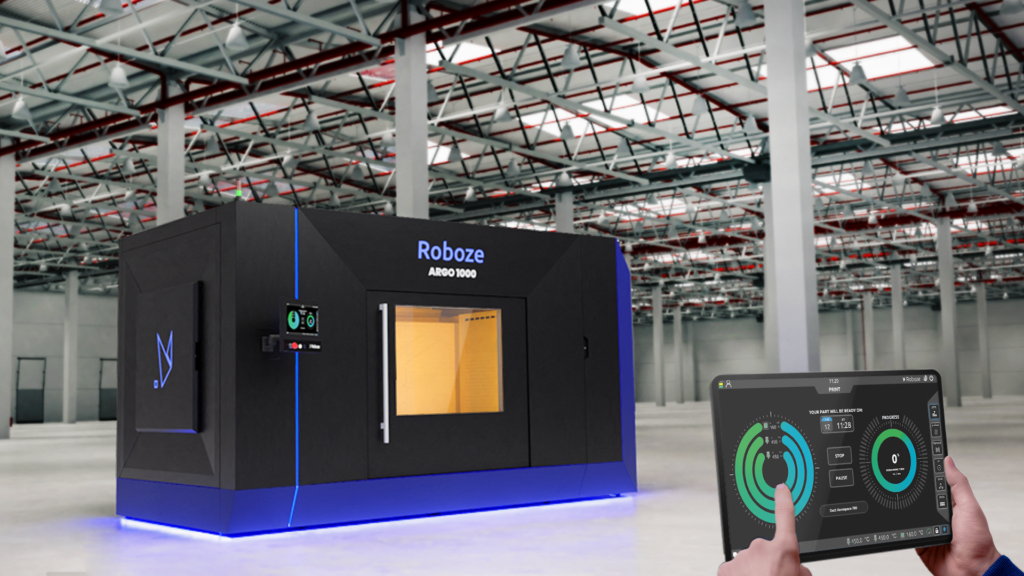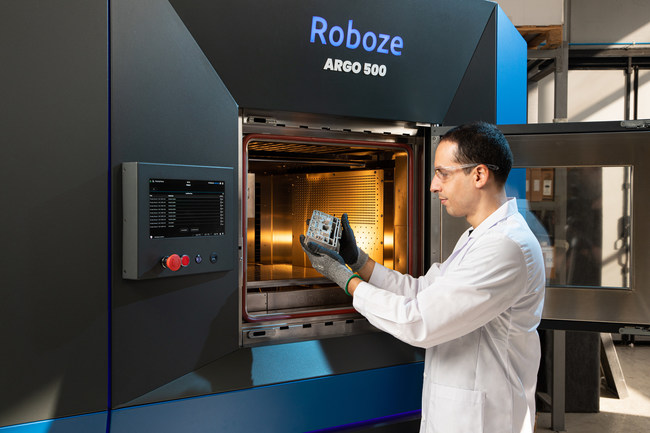Roboze has announced that it has received “several million” in funding, which will see the Italian manufacturer of high-temperature extrusion 3D printers expand its footprint and operations significantly. The company has said that it will use the investment to not only drive its movement in the U.S. and Germany, but that it will also be used to establish a new chemistry lab at Roboze’s Italian R&D facility.
Roboze was one of the first companies that cracked open the high-temperature 3D printing space, once monopolized by Stratasys alone. After the expiration of key patents, firms like 3DGence, Minifactory, INTAMSYS, 3ntr, and AON began introducing less expensive alternatives capable of fused deposition modeling (FDM) with performance materials, such as PEEK, highly popular in such industries as aerospace, oil and gas, space, and medical.

The ARGO 1000 3D printer from Roboze. The company describes it as “the world’s largest 3D printer equipped with a heated chamber for fast production of incredibly strong non-metallic parts.” Image courtesy of Roboze.
So far, Roboze employees over 100 workers and aims to hire 60 “super experts” throughout the U.S., Italy and Germany over the course of the next year-and-a-half. In the U.S. alone, Roboze hopes to hire 30 individuals across Materials Science, Chemistry, Business Development, Aerospace, Medical Devices, Field and Applications Engineering. Alessio Lorusso, Founder & CEO of Roboze, spoke to how the investment will be used:
“This further fundraising will accelerate our momentum in the United States and will enhance our investments in Research and Development. Specifically, the funding will assist in the creation of new super material in our Italian R&D center, where we are building a new chemistry laboratory. We are honored to have a group of investors of this caliber, who strongly believe in the vision of Roboze and in the change of production paradigm that our technology is enabling by replacing metals and producing parts without wasting raw materials.”
Among the firm’s customers is Siemens Energy, who is using Roboze’s technology to 3D print parts on demand, potentially digitizing warehouse storage.
“We think additive manufacturing is playing a key role in digitalization and cost out in the energy sector. At Siemens Energy we evaluated many companies and found that Roboze technology for high temperature polymers has met our engineering qualification and expectations. As a result, we acquired our first machine and look forward to expanding our relationship with Roboze.” commented Andrew Bridges, Service Frame Owner at Siemens Energy.
When we reached out to Roboze to ask what differentiates it from other companies in the space, Lorusso told 3DPrint.com:
“Here at Roboze we are producing finished end-use parts daily for customers with our industrial production grade 3D Printing machines. We still work with prototypes of course, but we excel in finding and solving the complex problems customers are having with getting to the finish line with a long-term solution, one that can be made additively and brought to the market.
“Production-level AM is here, and it is here to stay. At Roboze, this is an area we pride ourselves when it comes to innovation and remaining at the forefront of production practices in the realm of 3D Printing super polymer and composite materials.”

Roboze’s Argo 500 3D printer. Image courtesy of Roboze.
Roboze is a pioneer in high-temperature 3D printing and it seems to have been rewarded for it, taking on a slew of new investors. I’ll describe some of these investors here, as it is an interesting mix that highlights some of the possibilities for Roboze’s technology.
- Nova Capital, the holding company for Paolo Merloni, Executive Chairman of Italian heating manufacturer Ariston, which had annual revenues of about €1.57 billion as of 2017.
- Lagfin, holding company for Italian liquor firm Campari (annual revenues of € 1.816 billion in 2017)
- Andrea Guerra, formerly the CEO of Ray-Ban manufacturer Luxottica and now CEO of Louis Vuitton’s hospitality division, LVMH Hospital Excellence
- Luigi De Vecchi, Chairman of EMEA at Citi
- Roberto Ferraresi, CEO of Italian venture capital fund The Equity Club
- Luca Giacometti, CEO of the vehicle used by Shapeways to go public, Galileo SPAC
- Denis Faccioli, CEO of medical device manufacturer Tecres SPA
These join existing investors that include:
- Alfredo Altavilla, President of the Italian government-owned Ita Airways
- Boris Collardi, former CEO of Swiss banking house Julius Baer and later a partner at Pictet Group.
- Diego Piacentini, former senior VP of Amazon
- Federico Faggin, inventor of the world’s first commercial microprocessor
- Equiter SPA, an investment fund held by Italy’s largest bank, Intesa San Paolo, and Compagnia di San Paolo.
Among these investors, you see some of the usual sorts of 3D printing interests, such as medical device and industrial manufacturers, as well as bankers and financiers. One wouldn’t be surprised that the president of an airline is interested in 3D printing, given its increasing use in commercial aerospace. It is interesting that the CEO of a hospitality business is alongside the inventor of the microprocessor in backing Roboze.
These wealthy individuals and investment firms could simply see Roboze as offering exciting new possibilities in 3D printing for a variety of applications. The ability to produce high quality plastic parts on-demand serves countless uses. However, it would be interesting to imagine Louis Viotton relying on the technology to produce custom luxury goods for the rich clientele that uses its hotels around the world, such as the Cheval Blanc in the Swiss Alps. Or we could envision Roboze secretly researching electronics 3D printing, piquing the interest of Federico Faggin. More likely, Faggin is as enamored with an emerging technology from a company in his native Italy.
Subscribe to Our Email Newsletter
Stay up-to-date on all the latest news from the 3D printing industry and receive information and offers from third party vendors.
You May Also Like
3D Printing News Briefs, April 13, 2024: Robotics, Orthotics, & Hypersonics
In 3D Printing News Briefs today, we’re focusing first on robotics, as Carnegie Mellon University’s new Robotics Innovation Center will house several community outreach programs, and Ugogo3D is now working...
Rail Giant Alstom Saves $15M with 3D Printing Automation Software 3D Spark
3D Spark has entered into a three-year deal with the rail giant Alstom. Alstom, a transport behemoth with annual revenues of $16 billion, specializes in the manufacture of trains, trams,...
Meltio Expands Global Reach with New Partnerships in the Americas and Europe
Spanish 3D printing manufacturer Meltio has expanded its sales network across the globe. With the addition of three new partners in the United States, Brazil, Argentina, and Italy, Meltio aims...
3D Printing Webinar and Event Roundup: April 7, 2024
Webinars and events in the 3D printing industry are picking back up this week! Sea-Air-Space is coming to Maryland, and SAE International is sponsoring a 3D Systems webinar about 3D...































